Bushcrafting can be a defining activity in someone’s life and more people are starting to realize that.
Get your kids (and older adults) involved now!
by Leon Pantenburg
We all know that kid. He or she just doesn’t feel like they’re good at many activities. They’re average or below at sports, they’re not a standout in academics, and may be not interested in social activities. They don’t feel that school activities are really welcoming to them. That kid is the last one picked whenever the gym teams are chosen.
Maybe that kid needs to try different activities and bushcrafting may be it. Bushcrafting is a fun and simple outdoor activity where you get out in nature and develop skills that can help you survive and do well in challenging situations. While camping is existing in an outdoor environment, bushcraft is about interacting with the outdoors in a meaningful, productive way. The emphasis is on co-existing in a wild environment, while learning the techniques to survive.
Anyone can learn bushcrafting and common sense wilderness survival skills. For some, the activity becomes life-changing.

John Nerness and me on our first hike in Central Iowa in 1971. Pro tip: don’t go in August, or when the corn is pollinating.
“That kid” was me growing up. I had successful stints in solo track events (I qualified for the state track meet in the mile run), but organized, competitive sports were not particularly interesting to me. My small high school had limited clubs and I didn’t really join anything. I did love to read. As a book “worm” who also loved knives and guns, reading was one of my favorite activities, and it still is! For some reason, adventure tales intrigued me. Call of the Wild, Huckleberry Finn, Last of the Mohicans, and anything I could get my hands on about the eastern Longhunters was devoured.
I wanted to do adventurous stuff like those characters I read about. But in the late 1960s in Central Iowa, backpacking and cross country treks seemed like some exotic activity in faraway places. Mine was a community of farmers. I didn’t know anyone who had ever gone backpacking, much less bushcrafting.
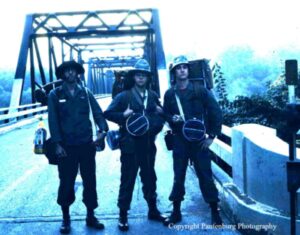
Babes in the woods: John Nerness, Mike Leininiger and me embarking on our first wilderness adventure in August, 1971.
Luckily, ‘niche nerds’ always find each other. When I was 17, I met John Nerness (he held the United Community High School record for the mile for many years) at the Hy-Vee grocery store where we worked. I already knew Michael Leininiger from high school. We three decided to try hiking. After several day trips in various places, we ventured to take a multi-day excursion, hiking along the Des Moines River in Central Iowa.
We were all impoverished Iowa State students and had no gear, so we went to the local Army Surplus store and bought what we could afford. None of us had much money to invest, and besides, who knew if backpacking would even be fun?
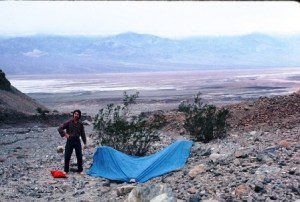
John took this photo of me in Death Valley National Monument in 1977.
Long story short, it was really, really fun. John and I have been adventuring together for 50+ years now, in places as diverse as Death Valley, California and the Okeefenokee Swamp in Georgia. Our last hike together was in 2017 before our distance from each other slowed down our trips. That’s why I encourage kids to learn bushcrafting skills when they’re young, while there’s so much life to live.
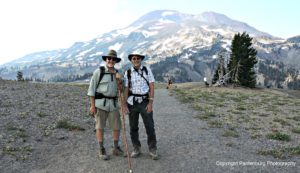
John and me hiking to South Sister in the Cascades in 2017. Smoke from nearby forest fires impeded the view.
Here are some good reasons for your children to learn bushcrafting skills.
My kids are well into adulthood now. They didn’t realize at the time that the skills they learned, hanging out with the old man, would serve them today. My daughter lives in earthquake country and feels confident in her abilities. She still has the Go-Bag we supplied together and her friends are amazed at her fire making ability on the windy California beach. She rock climbs, hikes, surfs, backpacks and camps. My son is in Portland, Oregon and has collected quite the stash of prepper supplies in his urban environment. They both travel throughout the west. Should anything go wrong for them in the city or the wilderness, I think they are ready.
WHAT CAN KIDS LEARN FROM BUSHCRAFTING?
Understand Preparedness: A bushcrafter is good at being prepared for anything. The tools and skills learned in the wilderness are easily transferred to urban and big city survival. Such skills as being aware of your surroundings and danger, starting a fire from materials at hand, or building a quick shelter are vital. Reading a map and purifying water are incredibly important during a natural disaster.
Couldn’t happen to you? Think Rolling Fork, Mississippi being leveled by a tornado, Hurricane Ian, or train derailment in East Palestine, Ohio. And what about those poor folks in Ukraine? In a wilderness or urban setting, literally anything can happen where you will need to think on your feet for water, shelter, food, warmth, survival.
Build Self-confidence: One of “those kids” was my friend Sean. I met him through the local Scouts program as a young lad and watched him grow up. He discovered flint and steel firemaking at a BSA campout and found he was good at it. Soon, Sean was an instructor, doing fire making presentations and teaching younger scouts. Learning bushcraft skills gave him a boost of confidence. Sean went on to become an Eagle Scout, and got a degree in Special Education. Now, he teaches bushcraft skills and flint and steel fire making at summer camps. His Scouting experience and loving the outdoors has given him a promising career and happier life.
Conquer Fears: Are you afraid of the dark? Do you even know? (Most people have never been in complete darkness.) Are you nervous about being alone? Don’t want to go off the beaten path because you might get lost? All these events could happen simultaneously in an instant. (Think earthquake.) Bushcrafting can help a child overcome fears and give them the confidence that might affect their survival in other apparently unrelated situations.
Master Your Own Fate: In day-to-day life we rely on other people most of the time. But during an emergency, you may be alone and have to rely on yourself and what you know.
Studies have shown (“Survival Psychology” by Dr. John Leach) that 80 percent of people in any emergency won’t know what to do, and will need someone to lead them. Another 10 percent will do the wrong thing. And the ones who survive, the remaining 10 to 15 percent, will survive because they rely on previous training. Bushcrafting skills can bring you peace of mind!
Enjoy Useful Craft Projects: Let’s go beyond cardboard boxes and construction paper. Simple, but useful, projects can make very efficient survival gear. For example, cotton balls infused with petroleum jelly are effective fire starters and they are very easy to make and carry. Put these fire starters in an empty prescription bottle and you have wonderful gifts for all occasions. Learn knife handling by whittling feather sticks. Use them for the fire the kids make in the backyard.
DIY: Doing things yourself is the basis of bushcrafting. The more gear you can make, the more money is saved for other survival items. Kids love to make things and you can’t imagine how proud they are of themselves until you see them do it. I have and it’s marvelous. You don’t want to scrimp on knives, boots or sleeping bag quality. But, the savings from DIY projects can be invested on quality bushcraft gear that won’t let you or your family down.
Re-kindle a Lost Connection with Nature: Most people would be clueless in a true survival situation, having been coddled by the comforts of civilization. Cloistered inside, with fresh water at the tap, warmth at the touch of a button and food delivered to our doors, we have lost touch with the natural rhythms and resources that keep us alive. Kids are craving this kind of connection with the earth – and frankly, with you.
Conversation Around a Campfire: It is always amazing to find out how many people have never built a campfire, much less sat around it and talked. For meaningful conversations with substance, sit around the fire in the dark. I’ve done this for hours with people who normally have their heads buried in their phones. When you get them around a campfire for three hours, there’s a lot to talk about, or sing about, make up ghost stories, tell urban legends, or play charades. It’s quote “a hoot.” Just build a little ring of rocks or garden blocks in your backyard and grab some folding chairs. Let the kids do all the work. It just may change your lives.
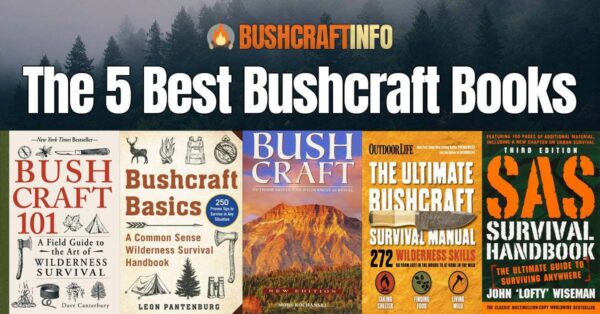
For more survival information, check out Leon’s book “Bushcraft Basics.”
Fun: Building fires, using knives and sharp objects, learning about plants and rocks, and making shelters is a lot of fun. And your youngster is going to have a good time because they will be outside.
Bragging Rights: A kid who has spent the weekend doing bushcraft will have a lot to talk about, and this will impress his peers. Compare that to the kid who spent the weekend inside, huddled in front of a computer screen, playing video games.
There is never a better time to get your child involved in Bushcraft. Who knows? Some day you might be really, really glad you did!
If you would like to book a custom wilderness survival trip down the Mississippi river and learn basic bushcraft skills, let me know. It’s simple for my team at Big River Wild Adventures to put it together and all you have to do is show up. Learn More.
Please click here to check out and subscribe to the SurvivalCommonSense.com YouTube channel – thanks!

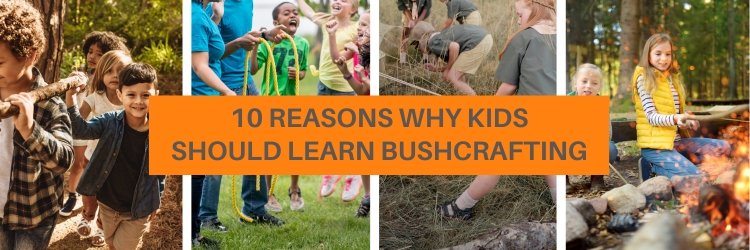
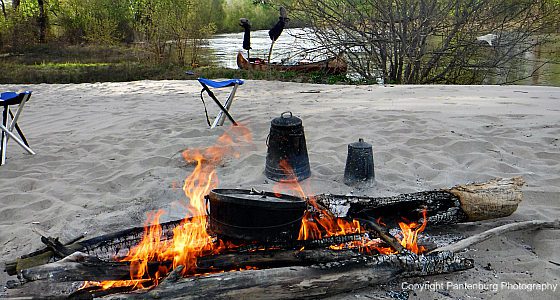

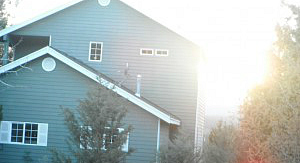
Leave a Reply